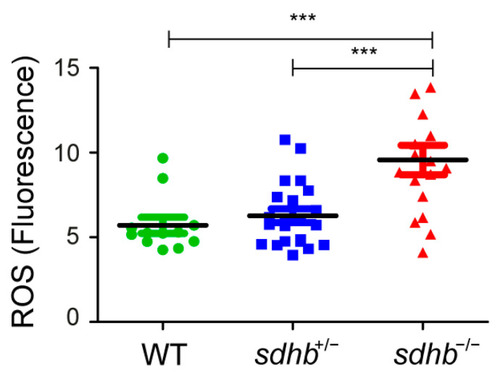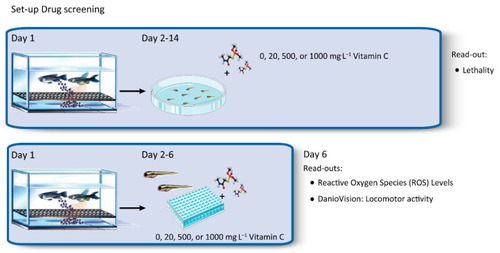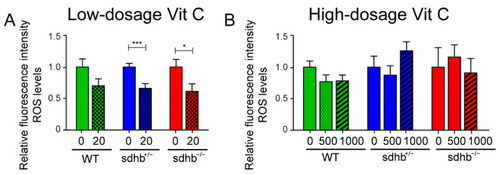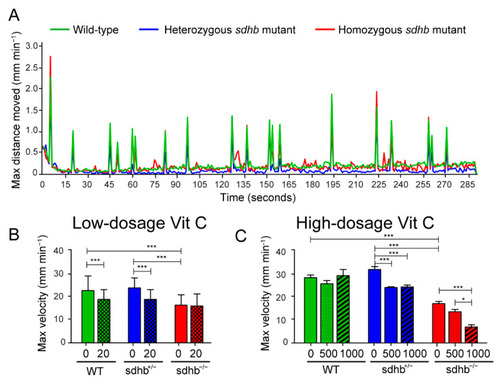- Title
-
Targeting the Redox Balance Pathway Using Ascorbic Acid in sdhb Zebrafish Mutant Larvae
- Authors
- Dona, M., Lamers, M., Rohde, S., Gorissen, M., Timmers, H.J.L.M.
- Source
- Full text @ Cancers
|
Reactive oxygen species (ROS) measurements showed a significant increase in homozygous sdhb larvae (n = 17) compared to their heterozygous (n = 22) and wild-type siblings (n = 12) at 6 dpf. One-way ANOVA with Tukey?s post hoc test, *** p < 0.001. PHENOTYPE:
|
|
Schematic overview of zebrafish drug screening set-up. |
|
Survival in WT siblings (A,B), heterozygous sdhb mutants (C,D), and homozygous sdhb mutants (E,F) presented for control (0 mg?L?1 green, blue, and red lines, respectively); low dosage ((A,C,E) 20 mg?L?1, purple line) and high dosage ((B,D,F) 500 mg?L?1, orange line; 1000 mg?L?1, grey line) Vitamin-C-treated larvae. (A,C,E) Survival rate (%) was not significantly prolonged after the low-dosage treatment of Vitamin C sdhb larvae compared to control (E3 medium supplemented; 0 mg?L?1) larvae (control: n = 95 homozygous sdhb larvae, n = 126 heterozygous sdhb larvae, and n = 85 WT larvae; 20 mg?L?1 Vitamin C: n = 112 homozygous sdhb larvae, n = 190 heterozygous sdhb larvae, and n = 91 WT larvae from two replicates). (B,D,F) Survival rate (%) was significantly reduced in homozygous sdhb mutants after treatment with high dosages of Vitamin C (500 and 1000 mg?L?1) compared to control (E3 medium supplemented) larvae (control: n = 72 homozygous sdhb larvae, n = 198 heterozygous sdhb larvae, and n = 87 WT larvae; 500 mg?L?1 Vitamin C: n = 84 homozygous sdhb larvae, n = 195 heterozygous sdhb larvae, and n = 70 WT larvae; 1000 mg?L?1 Vitamin C: n = 90 homozygous sdhb larvae, n = 172 heterozygous sdhb larvae, and n = 86 WT larvae from two replicates). No significant differences were observed between sdhb heterozygous and WT siblings at either low or high dosage Vitamin C treatment. Log-rank (Mantel?Cox) test, ** p < 0.01. PHENOTYPE:
|
|
Reactive oxygen species (ROS) measurements after a low- and high-dosage Vitamin C treatment. Relative average fluorescence levels are shown normalised to control levels without Vitamin C supplementation. (A) Larvae were supplemented with 20 mg?L?1 Vitamin C homozygous sdhb (n = 22), heterozygous sibling (n = 33), and wild-type sibling (n = 21) compared to the control group (indicated with 0 mg?L?1) consisting of homozygous sdhb larvae (n = 24), heterozygous sibling (n = 38), and wild-type sibling (n = 18) from two different replicates measured at 6 dpf. Low-dosage levels of Vitamin C significantly decreased ROS levels in heterozygous and homozygous sdhb larvae compared to the untreated control group. (B) Larvae were supplemented with 500 mg?L?1 Vitamin C homozygous sdhb (n = 12), heterozygous sibling (n = 24), and wild-type sibling (n = 18); 1000 mg?L?1 Vitamin C homozygous sdhb (n = 8), heterozygous sibling (n = 22), and wild-type sibling (n = 22) compared to the control group (indicated with 0 mg?L?1) consisting of homozygous sdhb larvae (n = 10), heterozygous sibling (n = 14), and wild-type sibling (n = 16) from three different replicates measured at 6 dpf. High-dosage levels of Vitamin C did not alter ROS levels in all three genotypes compared to the untreated control group. Two-tailed unpaired Student?s t-test, * p < 0.05 and *** p < 0.001. |
|
Startle response measurements at basal level and after low- and high-dosage levels of Vitamin C. (A) Optimized short protocol (<5 min in total) to quickly assess startle responses as a toxicity indicator induced by tapping stimuli with random intervals varying between 2 and 35 s. The max distance moved (mm min?1) is plotted against time per seconds. Between the wild-type (green line) and heterozygous mutants (blue line), no differences were observed, while homozygous sdhb mutants (red line) showed a decrease in moved distance. (B) Quantification of the average of the maximum velocity of three startle responses with or without the supplementation of low-dosage levels of Vitamin C (20 mg?L?1). Low-dosage levels of Vitamin C decreased the startle response of wild-type and heterozygous sdhb larvae while not affecting homozygous sdhb larvae. Larvae were supplemented with 20 mg?L?1 Vitamin C homozygous sdhb (n = 106), heterozygous sibling (n = 244), and wild-type sibling (n = 137) compared to the control group (indicated with 0 mg?L?1) consisting of homozygous sdhb larvae (n = 91), heterozygous sibling (n = 227), and wild-type sibling (n = 100) from five different replicates measured at 6 dpf. (C) Quantification of the average of the maximum velocity of three startle responses with or without supplementation of high-dosage levels of Vitamin C (500 and 1000 mg?L?1). Both 500 and 1000 mg?L?1 concentrations of Vitamin C induced a decreased startle response in heterozygous sdhb larvae, while only the 1000 mg?L?1 concentration of Vitamin C induced a decreased startle response in homozygous sdhb larvae and none of the high-dosage levels of Vitamin C significantly altered the startle response of the wild-type larvae. Larvae were supplemented with 500 mg?L?1 Vitamin C homozygous sdhb (n = 73), heterozygous sibling (n = 139), and wild-type sibling (n = 55), 1000 mg?L?1 Vitamin C homozygous sdhb (n = 20), heterozygous sibling (n = 37), and wild-type sibling (n = 19) compared to the control group (indicated with 0 mg?L?1) consisting of homozygous sdhb larvae (n = 32), heterozygous sibling (n = 48), and wild-type sibling (n = 40) from at least two different replicates measured at 6 dpf. One-way ANOVA with Tukey?s post hoc test, * p < 0.05 and *** p < 0.001. PHENOTYPE:
|





